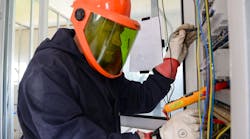Article 130 of NFPA 70E provides the requirements for work involving electrical hazards. All of Art. 130 (except Sec. 130.7) addresses such things as work practices and approach boundaries. Section 130.7, which comprises most of Art. 130 and includes several large tables, addresses PPE requirements.
These requirements take up a dozen pages. Our goal isn’t to provide you with a comprehensive rundown of what’s included and what it all means. Our goal is to give you an overview and some useful tips for using this part of NFPA 70E. Let’s start with a few basic tips:
• Take the time to learn about PPE. There’s been significant innovation in the past few years. Arc flash PPE in particular, is a far cry from what it used to be.
• Inspect PPE before each use. If it’s not in a safe and reliable condition, then replace it. If there is no replacement, the work will have to wait.
• Inspect PPE after each use. That’s the best time to notice you must replace it, not when you’re about to start the job and it has to be ordered.
• If in doubt, toss it out. If someone walks on an insulating blanket, does it still insulate? Do you want to find out the hard (maybe lethal) way, or ensure you’re safe?
• Store, transport, and handle PPE with care.
• You can overdo the PPE without penalty, but under-protection can mean serious injury or death.
• PPE gets in the way of injury, not in the way of work; adopt that mindset.
Sixteen requirements
You’ll find 16 requirements enumerated in Sec. 130.7(C). There’s extensive detail in these requirements, but here are some highlights.
The first requirement states you must wear PPE per Sec. 130.4 if working within the restricted approach boundary. But if working within the arc flash boundary, you must wear PPE per Sec. 130.5. The second one says the PPE must cover all of your ignitable clothing while allowing for movement and visibility.
The next six address requirements for specific body zones (e.g., eyes, hearing, hand, foot, etc.). The ninth requirement is particularly critical, as it explains the factors involved in correctly selecting protective clothing. The main thrust is protective clothing must fit properly and provide the rated protection.
New with this 2015 edition are subsections (A) and (B) under 130.7(C)(15): Selection of Personal Protective Equipment When Required for Various Tasks. These cover AC equipment and DC equipment, respectively. The difference is which Sec. 130.5 tables they refer to. The Informational Notes that go with these are longer than the requirements themselves but worth the read.
Before you get to the sixteenth requirement, you encounter several pages of tables.
PPE tables
Table 130.7(C)(14), Standards on Protective Equipment, lists 16 PPE-related subjects in one column and the relevant standard from the American Society for Testing and Materials (ASTM) in the other. For example, Fall Protection is covered by ASTM F887, Standard Specification for Personal Climbing Equipment. Want to know about insulating aprons? The table refers you to ASTM F2677, Standard Specifications for Electrically Insulating Aprons.
Knowing what ASTM standard applies to which PPE subject you’re interested in is beneficial, but in the typical work scenario you’re not going to refer to this table. That cannot be said of the next table — one that anyone performing electrical work should consult before beginning work.
This is Table 130.7(C)(15)(A)(a). It lists various tasks in the first column, equipment condition in the second column, and required PPE in the third column. This table applies to both AC and DC systems.
An important concept to understand in this table is equipment condition. A few of these tasks make the concept clear just by what they list in the “Equipment Condition” column versus whether arc flash PPE is required. Unfortunately, safe conditions are often assumed rather than known. Protect yourself by assuming it’s unsafe until proven otherwise. Ask yourself, “How do I prove this is safe?”
Let’s look at the list of conditions, all of which must be true for arc flash PPE to not be required for certain tasks:
• The equipment is properly installed. How do you know this? Incorrect installation might not be obvious from looking at the equipment, but that does not mean the equipment is correctly installed. Review the equipment history, if available. You may need to visually inspect the equipment; wear the appropriate PPE for that purpose.
• The equipment is properly maintained. If you work for a service firm, you’ll have to ascertain that qualified people have been maintaining this equipment per the recommended methods and at the recommended intervals. If you cannot readily ascertain that, the most likely reason is because it hasn’t happened. For example, you try to view the maintenance history in the CMMS, and nothing is there. It’s a safe bet the equipment is not properly maintained.
• Covers for all other equipment are in place and secured. You can verify this visually, and the same goes for equipment doors. Note: Look at each individual bolt head and/or latch.
• There’s no evidence of impending failure. Be careful with this one. If you’re responding to a malfunction and are there to troubleshoot, it’s safer to take that malfunction as a sign of impending failure than not to. After all, a malfunction does mean something is wrong; it could be the tip of the proverbial iceberg. For example, you respond to a breaker nuisance trip. It doesn’t necessarily mean a problem with the breaker, but it could. Treat it as such until proven otherwise.
The next table is Table 130.7(C)(15)(A)(b), the Arc Flash PPE Category table for AC systems. Table 130.7(C)(15)(B) provides similar information for DC systems. In order of increasing severity, the arc flash category can be 1, 2, 3, or 4.
So you know the arc flash PPE category. What are you supposed to do with that information?
For example, to cross the arc-flash boundary at panelboards 240V or below (19 in.), you need Category 1 PPE. Now go to Table 130.7(C)(15)(C). This table consists of four cells. As you may have guessed, those cells correspond to the four arc flash PPE categories.
These cells detail what PPE is required for each category. The requirements are similar; for example, all cells have the same “Protective Equipment” listing (hard hat, gloves, etc.) and all cells call for the same type of arc-rated clothing.
The one difference in the “Protective Equipment” listing is that in Category 1 leather footwear is “as needed” while it’s required for the other three. It’s not clear what other footwear is acceptable, but employers generally require leather footwear.
It’s smart to wear electrically rated safety shoes regardless of the minimum requirement. Not only do they help you look professional, but they also protect against non-electrical hazards. Have enough pairs so each pair can sit for a day between wearings to permit cushions to resume their proper shape. Take a cue from climbers: Eliminate odor by periodically spritzing the insides with white vinegar (let them air dry).
The big difference among these cells is in the first requirement, and it’s in bold text. That is the cal/cm rating of the arc-rated clothing. It’s 4, 8, 25, and 40 as you move from Category 1 through 4.
Insulated tools and equipment
The heading of Sec. 130.7(D) is “Other Protective Equipment.” Immediately below that is (1) Insulated Tools and Equipment. There is no (2), at least not yet. The first requirement (with some qualifiers) is that employees use insulated tools when working inside the restricted approach boundary.
This is followed by three rules [130.7(D)(1)(a)]. Insulated tools must be:
(1) Rated for the voltage on which they’re used.
(2) Suitable for the environment in which they’re used.
(3) Inspected before use.
The insulated tools requirements are followed by requirements for insulated equipment, in an ordered list (b) through (i). For example, among other requirements, portable ladders must have nonconductive side rails [130.7(D)(1)(e)].
After the insulated tools and equipment requirements are those for alerting. The first two requirements are for safety signs/tags and barricades [130.7(E)(1) and (2)]. These requirements tend to be followed without much problem, except that in some cases they don’t quite get the job done or don’t quite fit the actual circumstances. That’s where the third requirement [130.7(E)(3)] comes in: Use an attendant to provide manual signaling. You’ve seen this concept used in road construction.
Getting PPE right
Three important principles will help you get PPE right:
(1) PPE is not intended to make up for poor safety practices. The role of PPE is to add an additional layer of defense against hazards you may encounter when working on or near electrical equipment.
(2) It’s not about what PPE you “have to” use, but about what PPE will help protect you against the hazards you identify.
(3) PPE can’t protect you against hazards it’s not rated for. Be diligent in identifying the hazards.
Lamendola is an electrical consultant located in Merriam, Kan. He can be reached at [email protected].





